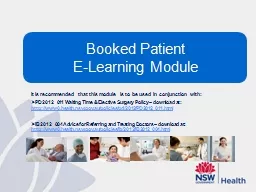PPT-Booked Patient E-Learning
Author : Littlespud | Published Date : 2022-08-04
Module It is recommended that this module is to be used in conjunction with PD2012011 Waiting Time amp Elective Surgery Policy download at httpwww0healthnswgovaupoliciespd2012PD2012011html
Presentation Embed Code
Download Presentation
Download Presentation The PPT/PDF document "Booked Patient E-Learning" is the property of its rightful owner. Permission is granted to download and print the materials on this website for personal, non-commercial use only, and to display it on your personal computer provided you do not modify the materials and that you retain all copyright notices contained in the materials. By downloading content from our website, you accept the terms of this agreement.
Booked Patient E-Learning: Transcript
Download Rules Of Document
"Booked Patient E-Learning"The content belongs to its owner. You may download and print it for personal use, without modification, and keep all copyright notices. By downloading, you agree to these terms.
Related Documents














